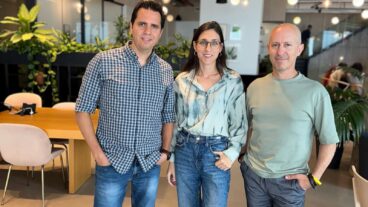The Weizmann Institute’s Canadian Institute for the Energies and Applied Research, one of the most sophisticated solar research facilities in the world, which has a solar tower, a field of 64 mirrors and unique beam-down optics.
Hydrogen, the most plentiful element in the universe, has long been viewed as an attractive candidate for becoming the pollution-free fuel of the future.
However, nearly all hydrogen fuel used today is produced by means of expensive processes that require combustion of polluting fossil fuels. Moreover, storing and transporting hydrogen is extremely difficult and costly.
In a breakthrough that has dramatic implications for energy use worldwide, Israeli researchers have shown that hydrogen fuel can be produced with the help of sunlight – propelling the dream forward of using hydrogen as a ‘green’ fuel.
The innovative solar technology developed at Weizmann Institute of Science that may offer an environmentally sound solution to the production of hydrogen fuel, has been successfully tested on a large scale, and also promises to facilitate the storage and transportation of hydrogen.
The chemical process behind the technology was originally developed at Weizmann on a scale of several kilowatts. It was then scaled up to 300 kilowatts in collaboration with scientists from the Swiss Federal Institute of Technology, Paul Scherrer Institute in Switzerland, Institut de Science et de Genie des Materiaux et Procedes – Centre National de la Recherche Scientifique in France, and the ScanArc Plasma Technologies AB in Sweden. The project is supported by the European Union’s FP5 program.
Results of the experiments were presented last month at the 2005 Solar World Congress of the International Solar Energy Society (ISES) in Orlando, Florida.
“After many years of basic research, we are pleased to see the scientific principles developed at the Institute validated by technological development,” said Prof. Jacob Karni, Head of the Center for Energy Research at Weizmann.
“Our presentation was very well attended and received. Our colleagues and people involved in this field know our work very well,” added Weizmann project leader Michael Epstein in an interview with ISRAEL21c.
The new solar technology developed by the Israelis and their European colleagues creates an easily storable intermediate energy source form from metal ore, such as zinc oxide.
Using Weizmann facilities, the team used sunlight to heat a metal ore, such as zinc oxide, to about 1,200° Celsius in the presence of charcoal. This split the ore, releasing oxygen and creating gaseous zinc, which was then condensed to a powder. The powder was later allowed to react with water, yielding hydrogen to be used as fuel and zinc oxide, which was recycled in the solar plant.
In recent experiments, the 300-kilowatt installation produced 45 kilograms of zinc powder from zinc oxide in one hour, exceeding projected goals.
The process generates no pollution, and the resultant zinc can be easily stored and transported, and converted to hydrogen on demand. In addition, the zinc can be used directly, for example, in zinc-air batteries, which serve as efficient converters of chemical to electrical energy. Thus, the method offers a way of storing solar energy in chemical form and releasing it as needed.
“Now we can store and transport solar energy efficiently as zinc, and then convert it to hydrogen whenever we need it,” team member Christian Wieckert of the Paul Scherrer Institute in Switzerland told New Scientist.
The concept of splitting metal ores with the help of sunlight has been under development over the course of several years at the Weizmann Institute’s Canadian Institute for the Energies and Applied Research, one of the most sophisticated solar research facilities in the world, which has a solar tower, a field of 64 mirrors and unique beam-down optics.
“We get 2000 times the normal sunlight concentration,” said Wieckert.
Weizmann scientists are currently investigating metal ores other than zinc oxide, as well as additional materials that may be used for efficient conversion of sunlight into storable energy.
“Over the next few months, there’ll be a continuation of tests to cover different process parameters, and the project will finish at the end of this year. We’ll have a final meeting with all the partners in the project,” said project leader Epstein. “The duration of the project was four years, but we’re actually planning to submit a continuation proposal to the next EU Commission.”
Reaction to the Weizmann breakthrough has been enthusiastic to say the least.
“The Israelis may save the world if this technique for producing hydrogen pans out and proves practical,” wrote Professor Juan Cole of the University of Michigan on his influential blog Informed Comment.
According to Epstein, the success of the recent experiments brings the approach closer to industrial use.
“We still need to demonstrate the whole process on a larger scale before it could go to commercialization. That can’t be done by us, we’ve done the largest tests we can with our means. But hopefully, industrialists will take it over and demonstrate it if can work one magnitude larger. If that is shown, and the economics are viable, then I’m sure it could be commercialized,” he said, adding that he foresaw the building of a commercial plant in six to eight years.












